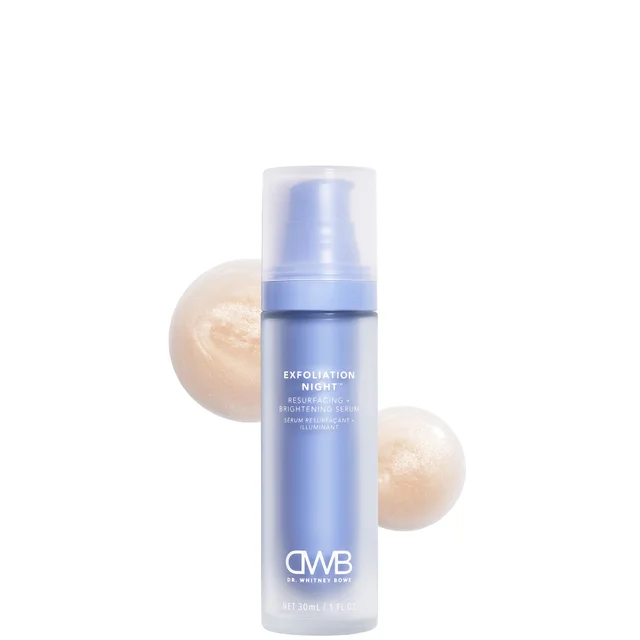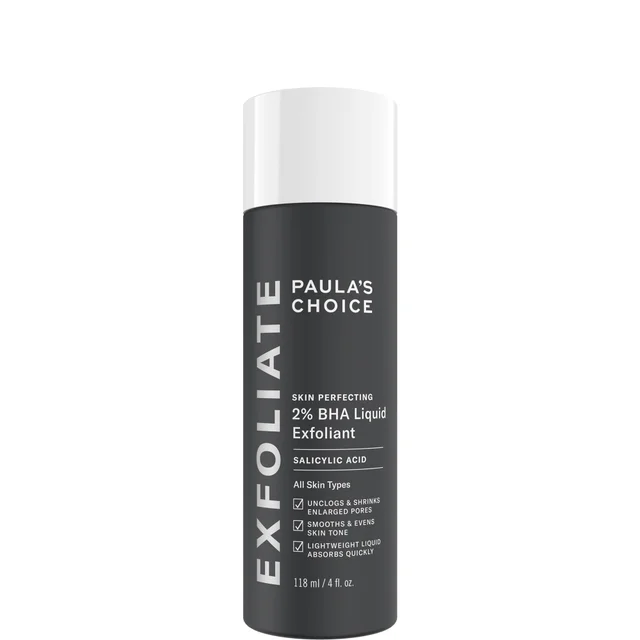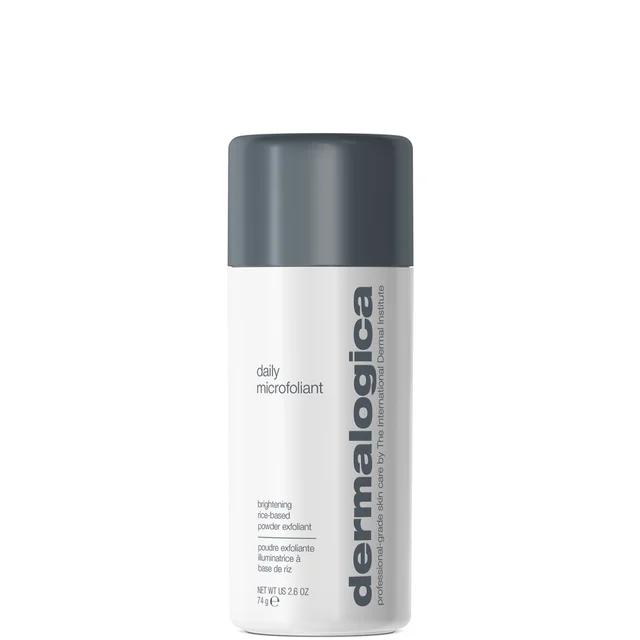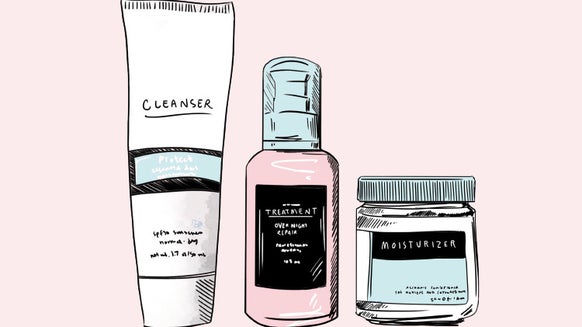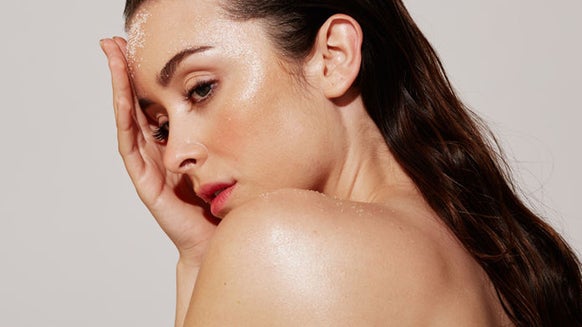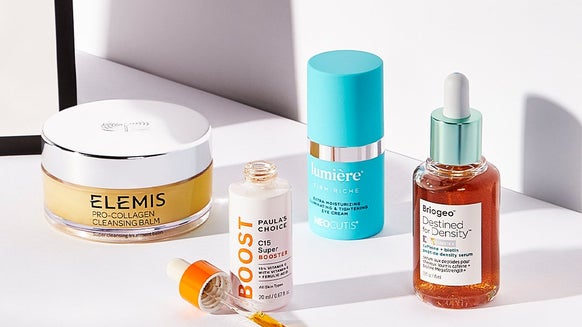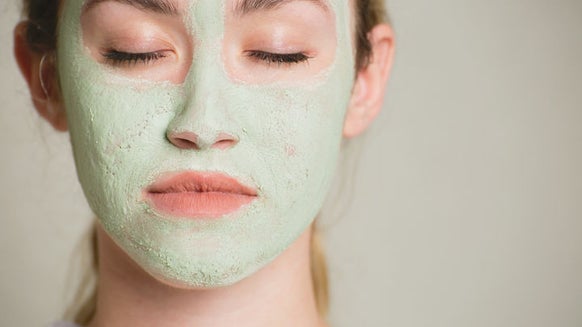Salicylic Acid for Skin: A Derm Explains Everything You Need to Know About This Acne-Fighting Hero
No matter what stage you’re at in your life, there are always some things that remain constant. The same can be said about skincare. Sun protection, moisturizing, and—to no one’s delight—even managing acne will always be front and center in your skincare routine regardless of age or skin type. Fortunately, you now know better than to pick at those pesky pimples and instead rely on a proven powerhouse: salicylic acid for skin.
From clearing existing breakouts to fading lingering post-acne marks, salicylic acid is a hardworking skin ally. Want to know how it can help you achieve your skin goals? Keep reading as we break down the transformative benefits of salicylic acid, plus expert-led tips on how to safely and effectively add it to your skincare routine.
Meet the Expert
Dr. Connie Yang – Board-certified Dermatologist and member of Dermstore's Medical Advisory Board
Derm Insights:
What it is: A beta hydroxy acid
Skin Benefits: Exfoliation
Target Concerns: Acne & blemishes, Dark Spots
Common Product Types: Cleansers, Creams,
Dermatologist-Recommended: Yes
In this Article
- What is salicylic acid?
- What does salicylic acid do?
- Benefits of Salicylic Acid
- How to Use Salicylic Acid in Your Skincare Routine
- Salicylic Acid vs. Benzoyl Peroxide: How They Differ?
- Can You Use Salicylic Acid with Retinol?
- Is Salicylic Acid Safe for All Skin Types?
- Best Salicylic Acid Skin Care
- Frequently Asked Questions
- The Bottom Line
What is salicylic acid?
A type of beta hydroxy acid (BHA), salicylic acid is known for being a chemical exfoliant and acne treatment, making it ideal for oily or acne-prone skin, says Dr. Connie Yang, board-certified dermatologist and member of Dermstore’s Medical Advisory board.
Modern skincare formulas typically use salicylic acid that is either synthesized in a lab or extracted from plants like willow bark and sweet birch. While its lab version is known for its precise concentration, stability, and consistency, salicylic acid from natural sources tends to be gentler on the skin and can be a good option for those with sensitive skin.
What Does Salicylic Acid Do?
Salicylic acid is a true powerhouse when it comes to managing and preventing acne, improving skin clarity, and fading blemishes. It’s a multitasking exfoliant that works both on the outer layer of the skin and within pores. On the skin’s surface, Dr. Yang says salicylic acid “can help shed outer layers of dead skin and smooth out texture,” helping fade post-acne marks and improve tone over time.
As a BHA, it shares many of its functions and benefits with AHAs or alpha hydroxy acids (like glycolic acid and lactic acid). Their main difference? Salicylic acid is oil-soluble while AHAs dissolve in water. “This allows salicylic acid to penetrate deeply into the pores to help dissolve dead skin cells and break down sebum,” explains Dr. Yang. In doing so, salicylic acid targets acne right at the source, diving deep into your pores and clearing out the gunk that’s fueling the breakout. Plus, it’s antibacterial, which means it helps eliminate and prevent the spread of acne-causing bacteria.
On top of that, salicylic acid also has anti-inflammatory properties that can help reduce redness and swelling, especially with big, painful pimples, says Dr. Yang. In other words, not only does it help clear acne, it also calms it down while speeding up the skin’s natural healing process.
Benefits of Salicylic Acid
Being the well-rounded ingredient that it is, salicylic acid offers a long list of benefits that go beyond treating pimples. According to Dr. Yang, here are the top reasons that make salicylic a skincare staple:
- Helps unclog pores by dissolving the glue that binds dead skin cells, allowing them to shed faster
Clears blackheads and whiteheads by decongesting pores Reduces sebum production for oily skin types - Brightens and evens complexion by improving tone and texture over time
- Treats keratosis pilaris or “chicken skin”
- Reduces dandruff when used on the scalp
How to Use Salicylic Acid in Your Skincare Routine
Salicylic acid for skin can be found in virtually every type of product—from cleansers and toners to serums and spot treatments—and picking out which one to add to your skincare arsenal depends on your needs.
If your goal is to manage existing breakouts and speed up their departure, go for serums and targeted treatments. If you’re beefing up your routine to prevent future breakouts and maintain skin clarity, then exfoliating cleansers and toners are your best bets. Just remember: the same rules you follow whenever you introduce your skin to a heavy-hitting active also apply to salicylic acid. In other words, start low and slow.
“I recommend incorporating salicylic acid into your routine gradually to minimize the risk of irritation,” says Dr. Yang. Start with once or twice weekly application to avoid unwanted reactions like excessive dryness, especially if you have sensitive skin. In the mornings, always use SPF as salicylic acid can make your skin more susceptible to sun damage.
Love layering or mixing and matching actives? With salicylic acid, Dr. Yang says it’s best to proceed with caution. Using several workhorse ingredients at once can be too much for your skin and may even do more harm than good. And that’s the last thing you want if you’re already dealing with stubborn acne. If you want to play it extra safe, talk to your dermatologist about how to use salicylic acid for skin to prevent overwhelming your complexion.
Salicylic Acid vs. Benzoyl Peroxide: How They Differ?
Benzoyl peroxide and salicylic acid are both top-tier acne ingredients, but they each have a different way of getting things done. Salicylic acid for skin is a chemical exfoliant, and although it has calming and bacteria-fighting effects, its true strengths lie in preventing clogged pores and speeding up cell turnover through exfoliation.
On the other hand, benzoyl peroxide is a no-nonsense germ fighter. It goes straight for acne-causing bacteria that contribute to inflamed pimples. It works fast too. It calms and dries out existing acne, helping them heal faster. Although it does its job a little too well sometimes it causes over-drying, flaking, and redness, especially if used in higher concentrations or without the right buffer or moisturizer.
Can You Use Salicylic Acid with Retinol?
Technically, you can—but Dr. Yang would rather that you don’t. “I recommend avoiding layering the two ingredients as it increases the risk of irritation. The exception being specific products that contain both ingredients as they are formulated to be used together at once.” If you must have both, make sure to use them on alternate nights and that you have a hydrating moisturizer and serum ready to counter excessive dryness and irritation.
Is Salicylic Acid Safe for All Skin Types?
Salicylic acid for skin is generally well-tolerated by most skin types. However, we also know that no single skincare ingredient comes with zero unwanted reactions. Nor is there a one-size-fits-all solution. “As with any chemical exfoliant, it can cause irritation if used too frequently or alongside too many actives. It can also make skin more photosensitive, so it’s important to use sunscreen daily,” explains Dr. Yang.
If your skin tends to be on the dry side or highly reactive, you may want to take your time with salicylic acid. “If you have dry or sensitive skin, salicylic acid can be irritating, especially at higher concentrations,” explains Dr. Yang. Your best bet? A sensitive skin-friendly formula with lower concentrations of salicylic acid (less than two percent), so you can reap its top benefits without putting your skin on the line.
That said, those dealing with inflammatory skin conditions like rosacea may need to skip salicylic acid altogether. Or, at the very least, use it with extreme caution and under the guidance of a dermatologist.
Best Salicylic Acid Skin Care
1. PCA SKIN Acne Gel
It’s time to send blackheads, whiteheads, and breakouts packing with the help of this fast-acting gel treatment and its advanced delivery system that makes it possible for salicylic acid to reach deeper into the pores, clearing out excess oil and dead skin cells at every turn.
Key Ingredients: Salicylic Acid 2%, Mandelic Acid, Hexylresorcinol and Ehtyll Linoleate
Skin Type: Acne-Prone, Oily, Combination, Normal
Skin Benefit(s): Clears existing breakouts and prevents future blemishes, regulates oil production, clears and decongests pores, promotes a smoother complexion
Beauty Insider Tip: This acne-fighting gel can be used two ways: as spot treatment for active blemishes on all skin types and full-face for oily, acne-prone, or combination skin.
2. CeraVe SA Renewing Lotion
Acne doesn’t just happen on the face, it can also show up anywhere on the body. This ultra-nourishing yet non-greasy lotion not only delivers essential moisture to parched skin, it also helps break down dead skin cells, excess oil, and keratin to prevent rough patches, uneven texture, and bumps caused by conditions like body acne and keratosis pilaris.
Key Ingredients: Salicylic Acid, Vitamin E, Ceramides
Skin Type: Dry
Skin Benefit(s): Alleviates dryness and dehydration, delivers long-lasting hydration, smooths bumps and rough patches, softens and smooths
Beauty Insider Tip: Apply after showering (or as often as needed) on arms, body, and legs for maximum absorption. Make sure to top it off with sunscreen to prevent sun sensitivity.
3. Obagi Medical CLENZIderm M.D. Pore Therapy
Hyperactive sebum glands? Don’t fret. This refreshing, pore-penetrating cleanser works hard to remove excess oil and debris while restoring pH levels and taking sebum production down a few notches—all to ensure your pores remain unclogged and your skin stays blemish-free.
Key Ingredients: Salicylic Acid 2%, Menthol
Skin Type: Acne-Prone, Oily, Combination
Skin Benefit(s): Exfoliates and unclogs pores, inhibits bacteria growth, rebalances pH levels, improves texture, soothes irritation and inflammation
Beauty Insider Tip: For brighter, clearer skin, gently massage a small amount of this cleanser all over face for 20 to 30 seconds before rinsing thoroughly. Make sure to wait until your skin is completely dry (around 10 to 15 minutes) before proceeding with the rest of your routine.
4. Dr. Whitney Bowe Exfoliation Night Resurfacing + Brightening Serum
Formulated by skin cycling creator Dr. Whitney Bowe herself, this award-winning and clinically proven serum delivers gentle yet powerful exfoliation. It sweeps away oil and debris while promoting cell turnover, setting the stage for clearer, healthier, and smoother skin.
Key Ingredients: 12% Glycolic, Lactobionic, Gluconolactone, and Salicylic Acid blend, Postbiotics
Skin Type: Dull, Mature
Skin Benefit(s): Exfoliates without irritation; refines fine lines, tone, and texture; instantly brightens skin; unclogs pores and prevents acne
Beauty Insider Tip: Thinking of trying out skin cycling? This serum is also specifically formulated for night one of the program.
5. La Roche-Posay Effaclar Salicylic Acid Acne Treatment Serum
Say goodbye to breakouts, enlarged pores, and post-acne marks with this targeted serum that combines multiple acids into one acne-fighting formula. And with the brand’s own thermal spring water also making an appearance, you can be sure you’re also getting nourished, well-hydrated skin.
Key Ingredients: Salicylic Acid 1.5%, Glycolic Acid, Lipo-Hydroxy Acids, Niacinamide, La Roche-Posay Thermal Spring Water
Skin Type: All skin types
Skin Benefit(s): Clears breakouts and prevents new blemishes, refines pores, fine lines, and post acne marks, reduces pimples and comedones
Beauty Insider Tip: Start with nightly application and work your way up to twice daily use. Make sure to layer under a non-comedogenic moisturizer and SPF for best results.
6. Medik8 Surface Radiance Cleanse Gel
This revitalizing daily cleanser features a supercharged multi-acid blend that deep cleans pores and delivers a gentle exfoliating boost while blurring common signs of skin aging.
Key Ingredients: Salicylic Acid, Lactic Acid, Mandelic Acid, Glycerin, Mangosteen and Raspberry Extracts
Skin Type: All skin types
Skin Benefit(s): Dissolves and removes impurities and excess oil, promotes a smoother and brighter complexion
Beauty Insider Tip: If you have sensitive skin, use this cleanser once daily or whenever your skin craves a deeper cleanse.
7. Paula’s Choice Skin Perfecting 2% BHA Liquid Exfoliant
There’s a reason this leave-on exfoliant is always on the best-of lists of beauty editors and skincare pros. Its clinically proven formula shrinks and decongests pores, controls oil, and blurs marks and blemishes while protecting the skin barrier. The more you use it, the smoother, clearer, and more radiant your complexion becomes.
Key Ingredients: Salicylic Acid, Green Tea Extract, Methylpropanediol
Skin Type: All skin types
Skin Benefit(s): Reduces oil and minimizes pores, reduces blackheads and whiteheads, strengthens the skin barrier, clinically proven formula
Beauty Insider Tip: New to salicylic acid? Start by applying every day and observing how your skin reacts. Once your skin has adjusted, use up to twice daily and finish with SPF in the morning.
8. Dermalogica Daily Microfoliant
Gentle enough for daily use, this exfoliant makes it possible for you to polish and resurface your complexion without worrying about irritation or stripping your skin. It speeds up cell renewal, removes trapped dirt and excess grease, and brightens a dull complexion—all while soothing existing redness and inflammation.
Key Ingredients: Salicylic Acid, Papain, Rice Actives, Colloidal Oatmeal, Antioxidants
Skin Type: All skin types
Skin Benefit(s): Gently exfoliates and decongests pores, brightens and evens skin tone, calms and soothes inflammation, antioxidant protection
Beauty Insider Tip: This exfoliant comes in a powder formula that activates upon contact with water. To apply, make a creamy paste by rubbing hands together and massage gently for at least a minute before rinsing off.
9. Glo Skin Beauty Beta-Clarity Clear Complexion Pads
Perfect for traveling or for busy days when time isn’t on your side, these convenient, pre-soaked pads instantly revive your complexion. Refreshing and clarifying, they come with a balanced mix of exfoliating and calming ingredients to detoxify, decongest, and comfort your skin.
Key Ingredients: Salicylic Acid, Spearmint Oil, AHAs
Skin Type: All skin types
Skin Benefit(s): Purifies and refines pores, balances oil production, blurs blemishes and clarifies skin, ideal for even the most sensitive skin
Beauty Insider Tip: This exfoliant comes in a powder formula that activates upon contact with water. To apply, make a creamy paste by rubbing hands together and massage gently for at least a minute before rinsing off.
FAQs
Do dermatologists recommend salicylic acid?
Absolutely. Salicylic acid is one of the most derm-trusted ingredients for managing and preventing acne, says Dr. Yang. “I recommend salicylic acid all the time to my patients with comedonal acne or those who struggle with oily skin.”
Does salicylic acid cause purging?
According to Dr. Yang, salicylic acid can cause purging, although it’s not as common as with retinoids. “Salicylic acid does increase exfoliation and speed up cell turnover. It clears out clogged pores, which can cause dormant pimples or microcomedones to surface more quickly. This may look like more breakouts, but it’s actually just part of the skin-clearing process,” she explains.
Does salicylic acid help with blackheads?
Yes, it does! In fact, it’s one of the most effective ingredients for minimizing blackheads, and with consistent use, it prevents new ones from forming. Because it’s oil soluble, salicylic acid can go deeper into the pores to remove trapped gunk, dead skin cells, and oil that can lead to blockages and blackheads.
Can salicylic acid help with acne scars?
If you’re mostly dealing with post-inflammatory hyperpigmentation and acne scars, then salicylic acid is your wingman. “It’s an exfoliant, so it can help gradually smooth out skin texture and lighten dark spots from acne,” says Dr. Yang. And although salicylic acid alone won’t be enough to fade deep scarring and discoloration, pairing it with niacinamide can enhance results.
What are differences between salicylic acid and glycolic acid?
Glycolic acid is an AHA, which means it is water-soluble and can’t penetrate into the pores as deeply as salicylic acid can, explains Dr. Yang. As BHAs like salicylic acid dive deep and work on dissolving deep-seated dirt, oil, and debris, glycolic acid exfoliates the surface of the skin. It’s ideal for brightening dull skin, blurring fine lines, and improving discoloration.
The Bottom Line
Salicylic acid for skin is neither hype nor an overnight miracle worker. What it is, instead, is an ingredient that delivers steady, targeted results that actually last. A proven powerhouse, it tackles acne, blackheads, post-inflammatory hyperpigmentation, and texture and tonal issues, especially in oily or acne-prone skin. Unlike AHAs, salicylic acid is oil-soluble and can penetrate pores better. It clears congestion, dissolves excess oil and debris, and reduces the chance of future breakouts. It is a reliable foundation in your acne routine, especially when used consistently and correctly. Paired with expert-backed advice and the right supporting ingredients, salicylic acid can help you achieve clearer, smoother skin with confidence.

Janeca Racho is a Journalism graduate with over 15 years of writing experience. After getting her start in public relations and advertising, she made the switch to freelance writing and began working for various lifestyle, fashion, and travel brands. Her love for all things skincare has led her to beauty reporting and research for the last ten years. Writing for several hair and beauty blogs, she reports on anti-aging staples, trending brands and products, must-have ingredients, and health and wellness.



